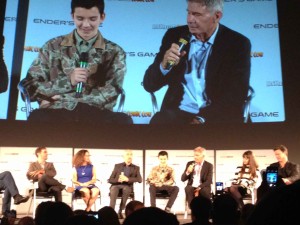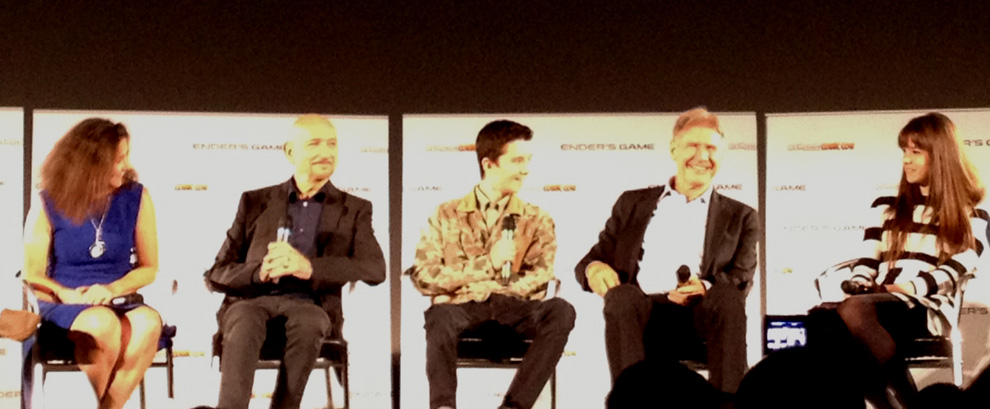 With Ender’s Game a movie almost 30 years after the novel’s publication, here is the Q&A hosted on 7th October 2013.
With Ender’s Game a movie almost 30 years after the novel’s publication, here is the Q&A hosted on 7th October 2013.
In attendance were stars Asa Butterfield, Hailee Steinfeld, Harrison Ford and Ben Kingsley, plus writer/director Gavin Hood and producers Robert Orci and Gigi Pritzker.
Centered on the boy Ender Wiggins (Butterfield) and his induction into a military training academy to battle an advancing alien threat, Ender’s Game is considered one of those classics of sci-fi literature.
With such big themes as child soldiers, shadowy government departments, gung-ho military and terrorist threats, despite being written in 1985 the book remains topical and prescient today.
Hailee Steinfeld is Petra, one of Ender’s few allies at the brutal Academy, while Harrison Ford returns to sci-fi as Colonel Graff, a brusque leader with divided loyalties, and Ben Kingsley portrays a mysterious, heavily tattooed mentor.
The movie has clearly inspired all involved (when was the last time Harrison Ford seemed this committed to a movie?) and were interesting when discussing the thirty year journey it has taken to bring the book to the screen.
Unsurprisingly, Ender’s Game’s controversial author, Orson Scott Card, was left out of the question and answer session, the panel preferring to discuss the book rather than the creator’s unfortunate opinions on gay marriage.
Host Craig Stevens provided amiable commentary, keeping the event relaxed, funny and informative.
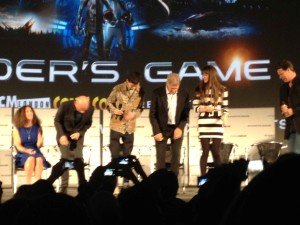 Crag Stevens (Host): First tweet is from Stefan Jones. He says Ender’s Game was published almost 30 years ago. Why has it taken so long to become a massive motion picture?
Crag Stevens (Host): First tweet is from Stefan Jones. He says Ender’s Game was published almost 30 years ago. Why has it taken so long to become a massive motion picture?
Gigi Pritzker (Producer): I had a nephew who read the book a long time ago and loved it and this was a boy who had a hard time reading. I read it too, thought it was terrific and then it took me 30 years to find Bob…
Robert Orci (Producer): The technology didn’t full exist and audiences had to be hungry for it. Audiences now see so many things we’ve already and hopefully they’ll see something they’ve never seen before.
CS: Gavin Hood, talking about the advancement of CG, was this something that couldn’t have been made 30 years ago?
Gavin Hood (Director): I’m hesitant in the presence of Harrison Ford to say something to do with science fiction couldn’t be made.
Harrison spoke very eloquently on the way over about how the battleships were made in Star Wars, how they were all models, he’ll tell you all about it.
The point is visual effects have reached a point where they are so good they can either be well used or abused. You can slam visual effects all over a movie and audiences will go, that’s cool but is there a story in here anywhere?
What I love about Ender’s Games is that it does have fantastic visual effects and we can render the battle room which fans love in this beautifully photorealistic way, but there is also a story that at its heart is about character and character interaction. So I hope you guys get two things, fantastic visuals and the themes, ideas and challenges from the book.
CS: Harrison, you’ve worked in this genre for many years and have seen CGI change. What are the fundamental things you saw on Ender’s Game that you didn’t see in the 70s and early 80s?
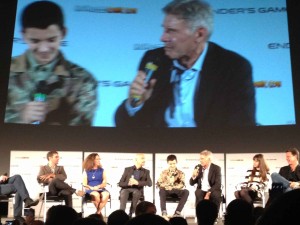 Harrison Ford (Star): Well, in the olden days we had very horse drawn effects. You put bits together and made a physical prop and now you can make anything in a computer and that’s basically the difference.
Harrison Ford (Star): Well, in the olden days we had very horse drawn effects. You put bits together and made a physical prop and now you can make anything in a computer and that’s basically the difference.
But, both methods work. The computer graphic perhaps allows you a little bit more latitude. But, it also allows you the potential to exceed human scale and overpopulate the screen, confusing the eye and emotion. From what I’ve seen we’ve not done that here.
One of the best things about science fiction is the bandwidth of imagination that you can use. And book did imagine 28 years ago the internet, touch screen technology, drone warfare, all of which is now part of our lives for better or worse. There’s a lot of wisdom and understanding in the book and hopefully we’ve captured quite a bit of it.
CS: Asa and Hailee, your first venture into the world of sci-fi, how was it for you working with a world of CGI?
AB: Neither of us had done a film with this level of CGI, hanging 20 feet off the ground with just the other actor and the wonderful Gavin Hood shouting instructions at us as to what the hell’s going on.
And you couldn’t do it without those instructions. We had a lot of fun experimenting. Gavin had a pre-vis of what it would look like, but nothing can compare to the final image.
CS: In America the book is part of the curriculum at school, but over here it’s not so known. How aware were you all growing up of this book?
RO: I haven’t read it, but it sound great… No, I read it when I was 12 year old, and I loved that it didn’t talk down to me, it celebrated intelligence and had complicated themes and was a great space adventure. So it hit all the sweet spots for a 12 year old.
GP: I read it as an adult and loved that a 13 year old boy and his aunt could sit and talk about its themes and inspire those conversations. It’s terrific.
Ben Kingsley (Star): I wasn’t aware of it all until I met Gavin in the Four Seasons hotel. He had his laptop with him and showed me all the beautiful graphics, talked me through his intention for the film and I realised I wasn’t looking at the graphics, I was listening hard to what he was saying, thinking this is just a really neat guy.
He’s strong, passionate, a great leader, with a broad intelligence and imagination. So his map of the book is what I took as the map of my character and the world he inhabited.
I know Gavin struggled to adapt the book because the novel is an internal process and what we had to do here is massively externalize what’s going on in people’s minds and imaginations and what they’re struggling with.
So my first and last impression will be Gavin’s interpretation of this clearly wonderful book.
CS: Asa, did you ever read it?
Asa Butterfield (Star): Yeah, I got it just after I read the script. I’m a massive fan of science fiction so this was right up my street. I loved the story, not just the character of Ender but the whole world in the novel is so beautifully crafted that I wasn’t sure how it could be brought to the screen. But, Gavin has done it amazingly.
CS: Gavin, the book is very much about what’s going on internally. When you were writing the script did you think, hang on, I can write this stuff but can I direct it? I might just change this bit, or, this’ll be easier?
 Gavin Hood (Director): First of all let me say thank you to my fantastic cast and their kind words. You don’t make a film alone, and I was supported by their talents and the talents of great SFX supervisors who are not here. So it’s a little embarrassing, but thank you Sir Ben and everyone. And we had a fantastic time.
Gavin Hood (Director): First of all let me say thank you to my fantastic cast and their kind words. You don’t make a film alone, and I was supported by their talents and the talents of great SFX supervisors who are not here. So it’s a little embarrassing, but thank you Sir Ben and everyone. And we had a fantastic time.
In terms of adapting the book to the screen, yes it is a very internal journey, but it’s also a great spectacle. The battle room is beautifully visually, as is the final simulation battle. They were challenging because when you read the book, and I hope this doesn’t come across the wrong way, but the battle room is just a black box room.
So I’d taken this job and thought, oh boy, now I have to decide what it’s actually going to look like, and if it’s a black box why am I up in space? Inspiration comes from crazy places, but I remember thinking, right it’s a huge glass sphere. And I hope you guys will embrace this, because you’re in this sphere so when you jump out, you feel like you’re in space. The sun’s out and the earth’s down below, so I took this idea to Gigi and Bob and I was really enthusiastic and they go, “Budget, budget, budget…”.
But, they immediately jumped on board and we developed it with a wonderful concept artist and production designers Ben Procter and Sean Haworth, and took it out to Cannes as a 45 second teaser piece. It wasn’t made with big studio money, the studios were afraid to make this story; they tried for many years and gave up. So we to raise the money from places like England, France and Germany and all over the world.
RO: I sold my house…
GH: So, um… it was a great experience…
CS: And he had such a lovely house. Hailee and Asa, your characters are at the heart of the film. Talk us through your characters’ relationship.
Hailee Steinfeld (Star): When you meet my character Petra, you know she’s been in the battle school for quite a while. When you meet Ender he’s instantly doubted by everyone in the battle school, who think how is he going to catch up to us and be as good as us; we’ve been here forever and worked so hard. Especially as our mentor is telling us Ender is the best of the best.
My character is one of the few girls in the school and the only girl in the Salamander army, so you assume she got originally quite a bit of doubt too from other people around her.
So, when Ender and Petra meet each other, they’re really not looking for anything but a friend. They’re placed in this world and don’t have anyone to look to, so when they find that within each other a special friendship develops.
CS: Were you aware when you got the script how layered the characters were, and was that plus the action in the script scary or a challenge?
AB: For me that was one of the intriguing parts of the story. Yes, it’s an epic science fiction adventure, but when you look into it there’s so much more behind that, which I don’t think many films today have.
Keeping all the ideas of leadership, friendship and choices and the struggle between people and inside themselves is a really interesting idea.
CS: Ender’s relationship with Harrison’s character Colonel Graff is… fraught. Graff’s quite hard edged and gritty. Did you keep that relationship offscreen so the onscreen stuff worked? And I’m so glad you’re sitting next to him and I’m not.
Huge audience applause.
HF: Asa’s a wise young man, who understood perfectly well what was going on. We both had responsibilities to the telling of the story and the character I play is both manipulator and mentor, and very misleading and seen through Ender’s eyes as strict and an obstacle.
But, when I play a character I’m not interested in deciding for myself if he’s a good guy or bad guy. He’s a person who is charged with a certain responsibility. There was a distance between that Asa and myself that Gavin and I talked about.
Gavin had a clear idea of what he wanted. He put all the kids through a space boot camp, there were drill instructors on set to teach them marching, cadence and all the military behaviour they need to replicate onscreen. I think Asa well understood that I was there purposefully holding myself slightly away.
Hopefully it was not a distraction, but an aid to the storytelling.
CS: Asa, what was it like that first day you walked in and had a scene with Harrison?
AB: My first time meeting Harrison was at a read-through in New Orleans all those many months ago. As I grew up I watched the Star Wars saga and Indiana Jones and I was very excited to meet Mr Ford.
Applause.
CS: As is the room. Gavin, what drew you into hiring Asa and Hailee?
GH: Well Hailee has done phenomenal work and is an Academy Award nominated actress. Hailee, I don’t think you know this, but I was looking at True Grit and saying to my wife, “This is a very restrained character and Petra is so much more charismatic”.
So I googled you and saw you in this interview. You were so bubbly and warm and I thought, my God she did some real acting in True Grit, she had to restrain herself and be this very intense young lady.
So your best audition was some interview you did, and I think you were wearing a red dress, so everyone go and find that.
And Asa’s work is fantastic in The Boy in the Striped Pyjamas and with Sir Ben in Hugo. And I spoke with Martin Scorsese who spoke very highly of Asa; we do do our little background checks…
But, Asa did send me a fantastic audition tape from London. And at this stage we were interviewing a lot of actors, and as you guys know the story takes place in the book between the ages of 6 to 13. I decided, and I hope you go with me on this, that we needed to compress this into a year so I wasn’t changing actors, so I started look at 7, 8, 9 year olds.
Let me tell, there are some talented little 8 year olds. But, when that talented little 8 year old came up against Col. Graff, not Harrison in the room but me doing a bad impersonation, and they’re going (high pitched squeak) “I don’t like you and won’t listen to you no more”, it was just horrible. You don’t have a movie, you just don’t have a movie.
So, we had to go a little older, so we edged up and Asa Butterfield sends in this phenomenal audition. He’s highly intelligent, he’s humble, he’s layered, a lovely guy, and on the cusp of boyhood just about to become a man. He grew two inches on set and made the wardrobe people crazy. Most of it was shot in sequence so Asa could develop his way through the show.
Asa and Hailee, I’m so glad I had you on this show, you did great work. And they’re delightful together, great hardworking young people.
CS: Gigi, you dreamed of making this movie for many years and now have an amazing cast of Academy Award winners and nominees. Was this the dream you had all those years ago?
GP: Oh, it far exceeded the dream I had. The reality is something extraordinary. When you hand material as good as this to incredible talent on both sides of the camera you get something special. People that Gavin’s mentioned, the production designers, the stunt coordinators, were all fans of the book and all wanted to see this film get made.
RO: The process of deciding on Sir Ben and Harrison Ford… you don’t decide on them, they decide on you.
CS: Let’s move onto Sir Ben Kingsley then. You have this incredible look in the film. I don’t know how much we can talk about your character; I don’t want to give anything away. Are we safe to talk about Sir Ben’s character?
RO: Sir Ben can handle any question you ask him, I have no worries.
CS: Let’s talk about the facial tattoo, which is stunning.
 BK: Well, as Harrison pointed out, this is a collaboration of the highest order. One layer or strata of actors are there to provoke and shape the cadets into what they planned. As well as that being the fictional story, that’s also the narrative occurring on the film set.
BK: Well, as Harrison pointed out, this is a collaboration of the highest order. One layer or strata of actors are there to provoke and shape the cadets into what they planned. As well as that being the fictional story, that’s also the narrative occurring on the film set.
The harder I pushed Asa the harder he could push back. I can’t moderate my performance and underestimate his qualities as an actor. Harrison also pushed him really hard and we got a good little kick and it was really exciting to see that.
My character has ancestral qualities to his tattoos. They’re all the generations of warriors from the Maori tribes of New Zealand he is descended from. He is a hard-edged, fighting machine warrior, almost mythologised for his warriorhood.
Part of the contribution Harrison and I brought to the younger performances is a strange lack of tenderness, which was difficult for us. But, when you then witness the tender moments they’re quite moving. We provide the contrast against which the colours of tenderness can shine.
When Hailee is tender, or Abigail (Breslin) is tender as Ender’s sister, or Viola Davis as the adult observer, those moments are heightened by our job, which is to remain brittle, hard and challenging.
Then, when you get those tender moments the audience feel it in their hearts.
My role in the film is like a flying spear. Just a simple, destructive machine and I wish to pass on my warrior technique and essence by devising tests for the children.
CS: How many hours of make-up were you in to get that tattooed look?
BK: It started off at two hours, but went down to an hour and ten minutes. But, I used it, I went still in make-up, I don’t chatter. I go very quiet, almost Zen. I run through the lines in my head and let the guys get on with their work, and never look in the mirror.
And after an hour and ten, which goes very quickly, I open my eyes and there he is, and I leave the trailer and go on set.
CS: We need to talk about the training school and the zero gravity. The first time you go into that room it’s like nothing you’ve seen cinematically before. Asa and Hailee, what was that like? I take it they didn’t take you up in the vomit comet?
AB: Sadly no. But, that was so much fun. We had quite a few weeks before filming getting up in the wires just to get used to what it was like up there. Then we had an astronaut come in to show us what it was like to be really in zero-gravity.
The stereotypes are that you would be slow and sluggish, but the reality is really different. We were taught how your body would naturally hang when you’re in zero gravity and it was all really interesting.
And when we finally got up there in our suits reading our lines we had such a blast. It was really hard work but we had fun doing it.
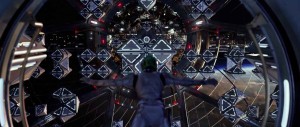 CS: How long did Gavin make you stay in that really uncomfortable harness Hailee?
CS: How long did Gavin make you stay in that really uncomfortable harness Hailee?
HS: Long enough to where we would just look at each other and laugh at anything that came out of our mouths. And also to the point where we realised we looked really funny upside down.
CS: They always say a director has one sci-fi movie in them. What are the challenges of sci-fi and are we going to get a sequel?
RO: We always say it’s bad luck to count your sequel before they’ve hatched. And also because we want to hear what you all thought about the work and get input about what was inspiring and put that into any future developments.
So, although I have a title we’ve barely finished this movie and want to make sure it gets the level of respect it deserves before thinking about what happens next.
GH: For me the time something takes place is a backdrop for a timeless, universal story.
Yes, Ender’s Game is set in the future and I hope we’ve created it beautifully for you, but at its heart it’s a universal story. As Sir Ben has said, this could take place in Ancient Greece or 100 years in the future. Humanity is very interesting, we’ve evolved technologically but something about us remains pure, which is why we can look back to Ancient Greece and look forward because we haven’t really evolved that much emotionally.
We need love, we get jealous, we feel betrayed and get manipulated and all of those beautifully human elements that happen to you and me happen to all the characters in the movie. So for me about it’s about finding a great story with an environment that’s really cinematic.
Rob Daniel
[youtube id=”2UNWLgY-wuo”]

